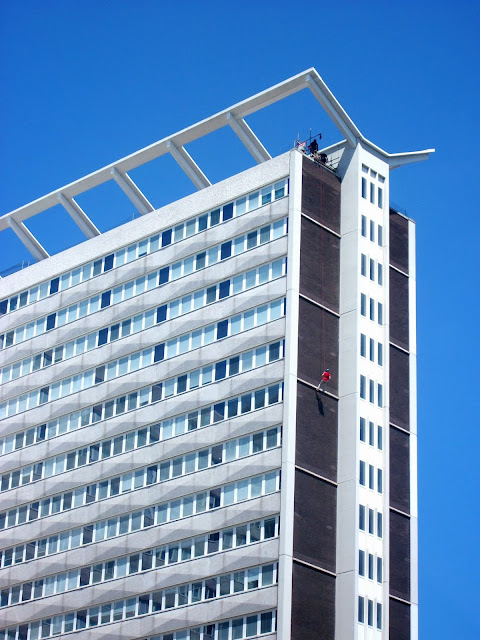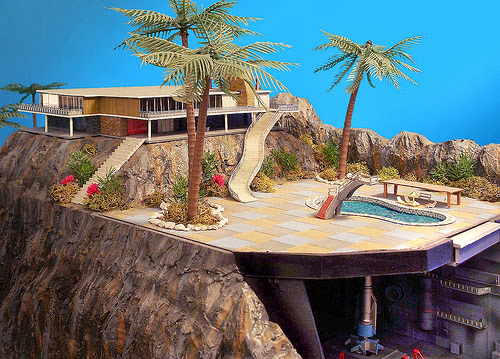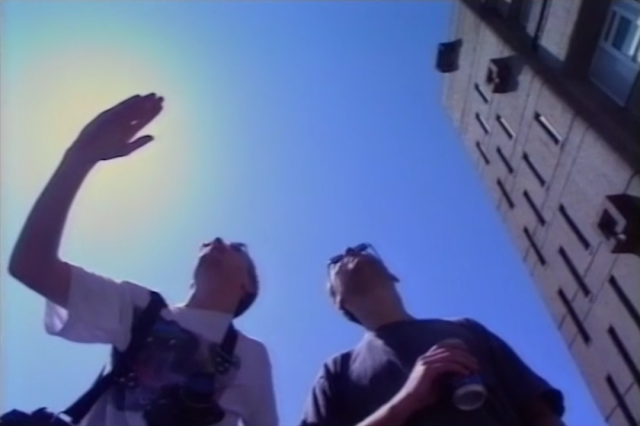Croydon gets it in the neck a fair bit. Soulless, drab, 'New York built in Poland', a concrete jungle. The Late Show in 1993 characterised it, in a rare moment of analysis from any media on the town, as an English Alphaville: comparing it to Godard's 1965 dystopian sci-fi masterpiece. And there are many elements of the town centre that deserve comparing to science fiction. There are 45 office blocks in the town centre, mostly built in the decade leading up to 1974. Most of these blocks stand on pilotis, Le Corbusier's word for concrete stilts, which allow people to walk beneath the buildings. In theory this makes them generous, makes them permeable. In reality, the vast tarmac car parks block access to them during the week when busy, and at the weekend when empty form a slightly uncanny zone around East Croydon, where you feel like your walking beneath the instep of giants. However, here I've chosen my ten favourite postwar Croydon buildings, those that most represent my home town. They also all reflect the space age in which they were built, and go some way to explaining my lifelong obsession with visions of the future from the past.
It's probably also briefly worth mentioning the less pleasant side of all this rebuilding: Croydon is a town all about money. These buildings were put up to capitalise on the 'Brown Ban' when Labour's deputy leader decreed that no high rise office space could be built in central London, and so Croydon, for a while, became a Docklands for the era of the trim phone and the Austin Maxi. But all of this Tory effort to make money out of every square footage of the town remains, currently in the ugly form of selling the library service off to construction firm John Laing, which sounds absurd and outrageous enough, without the fact that a couple of months in Laing have flogged off the libraries to a facilities management company in Wolverhampton.
All of this building is impressive, but don't for a moment imagine that Croydon's town fathers give a flying fuck about it. Which means that we have to. Let's not give in to their cynicism.
 |
1. Lunar and Apollo House
Like most of the office blocks in Croydon, these adjacent towers were built on land purchased by a private developer from a private tenant – in this case reclusive multi-millionaire Harry Hyams, who bought the land from Croydon High School for Girls, who took the money and ran to the suburbs. The names Lunar and Apollo couldn't place it any more in time: they were completed in 1970, the most famous buildings designed by Denis Crump and Partners, a practice not all all renowned for their 1st Mortlake Sea Scouts Headquarters. Most days there are queues of people waiting to see immigration staff as they belong to the Home Office. | |
|
 |
2. Corinthian House
Here's a lovely Richard Seifert building, from the team who gave us Alpha Tower and the NatWest Tower. Corinthian House is a bit tucked
away, overlooking a rather scrubby roundabout on Lansdowne Road. Seifert
often worked with Harry Hyams, but Croydon was an exception. Its glass
faces are beveled a little like those on Millbank Tower, and the pilotis are
classic Seifert, jazzily angled and covered in mosaic tiles, like those
on Centre Point or Space House. The elongated entrance canopy (captured
beautifully here by Ian Steel) is the cutest of all details on this little gem of a building.
|
 |
3. Leon House
I have two favourites among these buildings: this one and the next. Leon
House is an extraordinary staggered double tower, marooned in South
Croydon away from the swagger of its contemporaries, cut off by the
Croydon flyover. It's the most pure Le Corbusier-style block in the
town, built in austere grey concrete with a kind of elegance that few of
the other structures can match, and would look at home in most European
cities or the US, the kind of place Nixon would order to burgle. It was
finished in 1969, a year before the vastly inferior Lunar and Apollo
Houses, and designed by the firm of Tribich, Liefer & Starkin. |
 |
4. The NLA Tower
The Noble Lowndes Tower, Threepenny Bit or fifty pence building is the most recognisable landmark in the town. Partly because it towers over busy East Croydon Station, and so commuters travelling between London, Gatwick and Brighton get an eyeful of its offset octagonal floors and white mini-mosaic tiling, calling cards of Richard Seifert at his best. It's built on a roundabout, like Centre Point, and has a ramp that disappears into an underground car park beneath. It was finished in 1970, but the roundabout almost didn't make it, as that was planned to go though East Bridge House, whose tenant couldn't be persuaded to leave until three years later.
|

 |
5. Whitgift Centre
Croydon's shopping centre, with its five tower blocks, was built on the site of a school, like Lunar and Apollo House. Built by shopping centre experts Ravenseft, its claim to fame was starring in the original title sequence to Terry and June. These incredible photos are from 1971 and were taken by Ian Steel. My mum used a wheelchair so we always used the circular ramps – or whirlarounds, as we called them. My first job was, I think, just to the left of the second photo, in Sherratt and Hughes bookshop, now Waterstones. |
 |
6. Nestlé House
St George's House was the tower block famously built twice the height of Croydon's previous tallest building, Norfolk House, on the whim of Croydon's Borough Engineer, Allan Holt. It was soon occupied by Nestlé, who even branded the town at East Croydon, whose railway signs for years read 'home of Nestlé. St George's House was built at the end of a covered mall, St George's Walk, a place that lost out almost immediately when the Whitgift Centre was built, because of its unfortunate wind-tunnel design. The tower and mall were designed by Ronald Ward and Partners, most famous for their Thameside landmark, Millbank Tower. Nestlé have moved out, but their famous nest still towers over the town, cast in concrete 23 storeys up. |
|

 |
7. Suffolk House
Suffolk House was one of the first postwar buildings completed in the redeveloped town centre of Croydon. The mustard-coloured panels on this modest 3-storey office building place it in time quite as distinctly as the steel-framed curtain wall design. Here was late-fiftes architecture at its most polite. A noughties plan to replace it with a 40-storey glass-clad skyscraper came to nothing. I've always rather liked little Suffolk House, a building type more familiar to other less aggressively developed towns. |
 |
8. Fairfield Halls
There's no mistaking the resemblance between Fairfield Halls and the Festival Hall (and acoustician Hope Bagenal worked on both), except perhaps that these days while the South Bank has been polished and pimped to within an inch of its life, the Croydon version is looks more like a bingo hall by the day. Still, I saw some of the best things there, and I'm sure it's still managing that balancing act and inspiring and entertaining kids and families with the odd gem hidden among the rubbish. Picture (c) Frazer Ashford |
 |
9. Taberner House
The council offices moved out of the Victorian Town Hall building next door to this gigantic tower block, Taberner House, in 1967. Allan Holt had a hand in the design, which was chiefly handled by architect H. Thornley. It's undoubtedly one of my least favourite towers in the town, but the christmas tree created initially by leaving a triangle of lights on at nigt, and more recently through blue lights bought to decorate the building, is kinda sweet. Also, there's a story about my dad, a council caretaker, stumbling into a christmas party in drag, having accidentally improvised a costume from one of the other guests's clothes, that makes me laugh every time I see the big old tower. |
 |
10. Amp House
Here's one of my favourite buildings in the town, chiefly because of the amazing atomic-age relief above the entrance, and the concrete chevron panels surrounding it. Finished in 1968, the Amp House family group is the nearest the town centre comes to the kind of generous public art that new town dwellers are so familiar with. |























Superb photos and comments on our beloved Alphaville. Thank you for this, it makes a great accompaniemnt to The Late Show programme of 93. Amongst all this gleaming steel and drab concrete, an alternative croydon did flourish, especially during the punk era. Bit now, there is no Warehouse Theatre, no venues like The Star, Cartoon or wonderful Greyhound and Croydon again is slavishly waiting for the injection that commerce (ie Westfield) will bring.......out there somewhere is...... Alternative Croydon
ReplyDelete.....my first job was also in The Whitgift Centre.....Dolcis Shoe shop.....£38 for a six day week. hahahahha
ReplyDeleteMine was at Saphena Ltd, jewelers opposite Boots. £25 per week!
DeleteBlimey, it's like the refugees of the Whitgift Centre in here!
DeleteGood read, only clicked on the DG link because I grew up in Carshalton, and although the bright lights of the West End transfixed me from an early age, spent a fair bit of time in Croydon, mostly at the Greyhound punk nights in the 70s. Anyway on to my reason for this post. I spent a couple of years in Folkestone and Dover, for work, 20 plus years ago, and in Folkestone there is a building almost identical to Suffolk House, if memory serves, and is in almost exactly the same setting, with the sea to the right and behind, in Kent. All the best, Kev
DeleteThe Late Show was amazing. Glad you enjoyed the pics. Such a shame that alternative scene died out in Croydon, even if the spirit didn't.
ReplyDeleteThe alternative scene in Croydon definitely didn't die out! Big Apple Records was (maybe still is!) a hub of activity for the 1990s and noughties jungle and drum 'n' bass scene and then the dubstep scene. Plus many warehouse parties and raves took place around Croydon industrial estates in that period! I don't know what followed that - sadly out of touch these days!
DeleteGreta article and pictures - really enjoyed both! Stumbled across your site while looking for pics of AMP House for a project at work - didn't think I'd find myself writing this comment!!
I bought your book last week and very much enjoying it, not particulary a fan of these kind of buildings I prefer old, but I have always enjoyed photographing derelict buildings when I come across them and would fancy a visit to some of the places mentioned.
ReplyDeleteCheers Paul. There's so much cool stuff to photograph in Croydon, if I was any good as a photographer I'd be snapping away there every day... It's all change there again now too, worth capturing things before they vanish.
DeleteThis was a lovely write up on Croydon's post war development phase aided with some lovely paraphernalia.
ReplyDeleteI recently assisted Rob Mowbray in curating 'Ghost Town', an exhibition at Croydon's School of Art investigating the notion of Hauntology and the effect Croydon's Post war brutalist development has on Croydon now.
We even have a collection of original postcards including the ones you have displayed on this blog.
Please have a look at the review I wrote up and feel free to come down! The exhibit is still on and I am developing artwork celebrating the brutalism and embracing the chaos which will soon be exhibited and for sale.
http://greatdesignerssteal.wordpress.com
I'm so gutted I missed the exhibition. It looked great. What next?
DeleteA while back I wondered what would have happened if the Late Show had been less prejudicial in their editing and choice of soundtrack...here's the result...see what you think: http://youtu.be/c6LbdUP7Dhw?list=UUnBu4fnaNdu78o5DNoC9Zzw
ReplyDeleteBrilliant. I love seeing how much re-editing changes the whole thing...
DeleteFascinating - but it's Taberner (not Tabener) House, named after E. Taberner, the long-serving Town Clerk whose name appeared on all official signs of the era; and AMP (not Amp) House - Australian Mutual Provident Society.
ReplyDeleteHey John this is a great site and I'm just finding it now.
ReplyDeleteI'm gonna check your Concretopia book out of the Library too.
Your Croydon posts are a particular interest. I was a 70s 80s New Addington Croydon kid. First Good Shepherd then St Marys in Croydon, going past the 50 pence piece building 5 days a week on the 130 route master and the C buses.
Boy in winter that journey was ridiculous! Endless buses packed like baked bean tins eaking their way back and forth through Shirley hills at a snails pace in traffic jam in early morning pitch black.
My mum worked at Lunar house in the mailing and paper keeping depts.
Is it any wonder I ended up living in a reclad refurbished hi rise in Glasgow with stunning views of the Southside.
It's off architectural topic but theirs a real political social and moral story to be told about New Addington. It's geographical location, planning and isolation (literally shunned/blocked off from affluent areas slap bang next to it) and the affect it had on its residence and their lives. Theirs many a dark story that needs telling.
The last time I went back was in the 90s prior to the Tramlink and the bus services to Biggin Hill and Bromley starting up. But digging online these things appear to have little affect. More people appear to pass through but little reason to stop and interact.
When I consider certain aspects of my growing up in it. The quality of housing (I was in in Fieldway Applegarth the New Estate) was of a high standard (the open metal fencing of the gardens was s privacy nightmare though. My dad eventually put up high wooden creosoted panels) The library, the swimming pool were all virtually brand new fantastic facilities within easy access by foot or bus. It has strong utopian aesthetics and social philosophy going on. Yet we were virtually 2nd class citizens in Croydon and an New Addington address affected people's job prospects and their cultural lives and still does.
Anyway, I 'got out' but it does haunt my thoughts.
Hi David, great message, thank you.
DeleteI was also a New Addington kid, and lived on Fairchildes Avenue for 30 years, and so recognise so much of what you're saying. I hopoe I've tried to tell a bit of the social story in Concretopia, but it is such a curious place, it needs a dedicated work.
Amazing you now live in a Glasgow tower, you've really done the whole postwar modernist story there.
J
Hi John
ReplyDeleteI came along to the Ballard day at the British Library and really enjoyed the discussion about Brutalism that you took part in. I'm doing a review of High-Rise to go in this week's Croydon Advertiser and wanted to do a side-piece on Croydon and Brutalism. Would you be up for sending me a few quotes on this? I could give Concretopia a plug in the piece if you do fancy it.
I'm an Essex man myself and we've got our own concretopias in Harlow and Basildon which I'm sure you're familiar with. I must admit I grew up thinking these places were rather ugly but over the years Brutalism has grown on me and I'm really interested in it now.
Here's a version of my review that's online at the moment http://chillidogmovies.blogspot.co.uk/2016/03/film-review-high-rise.html I don't go into much detail about Brutalism as I thought that could be a separate piece.
If you do fancy sending something over, my email is darryl.webber@essexchronicle.co.uk or darrylwebber21@gmail.com
All the best,
All the best,
Darryl
All of these are so familiar. Thanks in particular for the reminder about Sherrat and Hughes. I spent so much time in that place. Did my first ostentatiously intellectual reading in the cafe at the nearby branch of Habitat.
ReplyDeleteYou guys have interesting memories of Croydon as have I. My mother used to take me with her shopping in Croydon years ago.
ReplyDeleteI Found this site by chance and loved looking at the pictures. I lived there from 1960-2004 and have seen many changes, good and bad, over those years. However out of all the high rise blocks my favourite has always been the NLA Tower which is so distinctive, luckily ideas to scrap it have failed, so far.
ReplyDelete